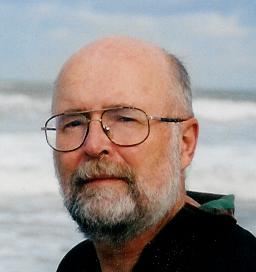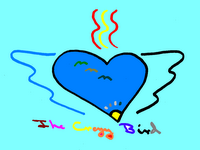 An impression I received one afternoon when I was about fourteen years old while watching bubbles rain drops made on water has followed me all my life:
An impression I received one afternoon when I was about fourteen years old while watching bubbles rain drops made on water has followed me all my life:Simmer rain on streets black asphalt, bubble ships on sheets of water
I described this impression in the first of this series, "Bubble Ships". In the second, "Bubble Ships -- Conscious Awareness", I tried to combine that with another impression I received when, at the same age, I often looked up and saw the Milky Way on a clear night stretched across a black velvet sky in Poosah City.
That I could acquire such impressions is because I live on a world where life appeared some four billion years ago, life which has evolved and which, in the form of the human being, occasionally manifests conscious awareness.
There are a lot of questions which can be asked regarding how it all came about, but, first, let us take a look at this planet at the very beginning, when our Earth was quite new, some four and half billion years ago.
Usually, people say that the Earth was then barren. But, this is misleading for, as we know, She has proven herself time and again to be quite fertile.
The Moon is barren, but not our Earth.
It is not for nothing that many, myself certainly included, call the Earth our Mother.
But, how did it happen to happen that the Earth got there in the first place? The answer is that Something Happened a long, long time ago -- at least twice as long as the age of the Earth today.
What Happened? We can't really say, but we can say things about it, for example:
A thought so heavy that it fell into space...
We can also say that, almost instantaneously after What Happened, there was a point of intense energy and potentiality which defined the entire manifest Universe we know today. This point, or singularity, is what we call the Big Bang.
Immediately, that point blossomed and, with a strange blend of chance and inevitability, out-folded into what we today know as the manifest Universe. That is to say, according to its nature, it expanded and cooled.
As it cooled, the energy became plasma, then curdled and curled up into tiny bits of particles with strange names and, eventually, into hydrogen ions, atoms and molecules mixed up with a pinch of helium.
"O well, that was a nice show!" remarked some of the younger angels, who figured it was time to pack up and go home (where ever that was!) before it got dark...
However, whatever Happened did so with a bit of a twist with the result that the hydrogen dust sort of swirled and clumped together.
(More than one of our creation legends refer to a curdling of primal "milk" or "blood" and that intuition is not a bad, albeit non-mathematical, description of what happened.)
The reason for the "curdling" is that there were at least four forces at work, forming the stuff of this universe in ways we barely comprehend so that it eventually out-folded into the manifest Universe in which we find ourselves.
A fifth force is suspected by some of those who study these things -- this may be another wild-goose chase of science -- or there may a number of other forces we haven't even inkled yet.
Whatever, we know now there are at least four and what they can accomplish in concert is pretty amazing.
The bigger clumps tend to bend space a bit so that smaller clumps and dust from the clouds "fall" into bigger clumps which get, well, bigger.
Kind of interesting at first, but after a billion years or so, it does get boring -- time to go home (again) -- but then, who would have thought that, as those clumps get bigger and bigger, they scrump into themselves they get warm and start to glow, albeit very dully.
It all just doesn't get just colder and further apart. Some of it gets closer and hotter. The younger angels are amazed and they settle down with another bag of pop corn.
The clumping together happens because of one of the four forces -- gravity. A second force, electromagnetism is responsible for the dull radiation.
Eventually though, it looks like this too will peter out, but then, something else happens that you never would have thought -- until you see it happen, then you know it was inevitable.
Gravity is a very weak force compared to electromagnetic force, but its reach is unlimited. Apparently it is a quality of matter -- the more matter and the closer together matter is, the more gravitation.
Although weak, gravity is the like money accruing interest in the bank. If you accumulate enough, it becomes irresistible.
Deep, deep, deep inside the biggest clumps, gravity gets so strong and everything gets so squished, that some of the hydrogen atoms meld together.
This melding is called "fusion" and it gives a bit of a bang, releasing a lot of energy. We (mis)use this little trick to make the terror weapons we call "hydrogen" bombs.
Some one in the back row just asked ask why these hydrogen atoms don't meld on their own when they get close.
The "reason" is that hydrogen ions -- protons -- repel each other. They all have a positive electric charge and, since the electromagnetic force is much stronger than gravity, it keeps them apart.
It's like trying to put the north poles of two magnets together -- they just don't "want" to do it. You can press them together as long as you want, but as soon as you let go, they spring apart.
However with hydrogen cores it's a different story, if you press them real close and it's really, really hot -- something strange happens you would never have suspected if you hadn't seen it happen: a third force comes into play. This force is immensely stronger than gravity or even electromagnetism. Therefore, we call it the "strong interaction". That name, although descriptive, is a bit clumsy. I would prefer it was called "nuclear glue".
Nuclear glue, or "nuglue", although very strong, does not have a very long range. As a matter of fact, it can barely reach further than the distance of an atomic nucleus before its effect fades. A lot of energy is needed to get the protons and neutrons close enough together so that the nuclear glue can grab ahold and overcome the repelling effect of electric-magnetic force.
However, if you smack them together hard enough -- they sort of "snap" together with a "click", that is, a release of energy. In this case, a lot of energy -- in fact, much more energy than needed to bring them together in the first place. The extra energy is more than enough to get more hydrogen to "burn" in this fashion.
The "ashes" of thermonuclear fire in a star are helium and a few of the heavier elements.
Very interesting, our angels say -- it gives us Helium, which is nice if you want to sell balloons at a county fair or talk like Donald Duck, except that aren't any balloons or country fairs, not for a looong time anyways...
"That will all come in due time", reply the older angels.
The important thing is that the ignition of thermonuclear fires in the bigger clumps of hydrogen dust is that it is inevitable, given the way that the energy of the Big Bang sort of curdles and curls into the first particles and clouds of gas..
These particles must clump together, because of the effect of the first two forces, gravity and electromagnetic force.
Fusion of the first nuclei must occur, because of the third force -- that of strong interaction -- "nuglue".
It is also inevitable that some of these thermonuclear fires will burn completely out of control and explode in one of several different ways.
We don't know all that much about these explosions, except that their magnitude ranges from the incredibly enormous to completely off the scale, dwarfed only by the Big Bang itself. These explosions are inevitable, simply because it is a quality of the nature of matter and energy.
Besides the fireworks, these explosions are important to us because they generate all the heavier elements! The forces generated in these cataclysms are so great that nuclei are slung together, and all the other elements are fused in these events. Some of the elements, in particular the heaviest, are unstable and tend to fall apart in a decay we know as radioactivity. This is the work of the fourth force -- the weak interaction or "nuclear glue disolver".
[If I can work faster than I did in preparing this post, I will try to communicate some of the things that have always amazed me about chemistry -- especially that of water and cabon]




No comments:
Post a Comment